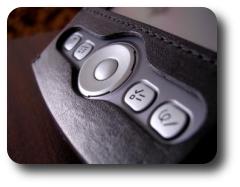 S recently as January this year, I proudly spoke about data resilience in Palm PDA‘s. Now, on the other hand, I am slightly more hesitant in making such bold statements, having screwed up big time. Allow me to elaborate in a stream-of-rage fashion (this won’t be too eloquent).
S recently as January this year, I proudly spoke about data resilience in Palm PDA‘s. Now, on the other hand, I am slightly more hesitant in making such bold statements, having screwed up big time. Allow me to elaborate in a stream-of-rage fashion (this won’t be too eloquent).
 While my general opinion (and confidence in Palm) has not changed much, this morning I was a victim of data loss. This cost me about 3 hours, a loss of data that I cannot truly recover, and a huge headache (metaphorically-speaking, through distress). To describe the ordeal in brevity, I woke up to discover that my Palm’s battery was empty. I thought the unit was dead until I had it charged and could reset it. I could soon come to grips with the fact that my main, volatile memory was void (not ROM). I then realised that the batteries got emptied without any prior notification. I left the handheld in my trousers’ packet overnight, rather than dock it on the cradle as I usually do.
While my general opinion (and confidence in Palm) has not changed much, this morning I was a victim of data loss. This cost me about 3 hours, a loss of data that I cannot truly recover, and a huge headache (metaphorically-speaking, through distress). To describe the ordeal in brevity, I woke up to discover that my Palm’s battery was empty. I thought the unit was dead until I had it charged and could reset it. I could soon come to grips with the fact that my main, volatile memory was void (not ROM). I then realised that the batteries got emptied without any prior notification. I left the handheld in my trousers’ packet overnight, rather than dock it on the cradle as I usually do.
The drainage took my by surprise. The last HotSync operation took place 24 hours earlier, but backup files were no good under KPilot, which can be odd and inconsistent at times, despite my praises. To make matters worse, it was the past 24 hours when I made the most changes, some of which were crucial and spanned a period of months. But it gets worse…
I attempted recovery in vain. I fortunately had one backup which was one week old in my peripheral SD card. I could recover with the loss of one week. To avoid this considerable time gap, this afternoon I bought a USB card reader. I thought it would enable me to modify the backup on the SD card using Red Feline Backup — that which I mentioned a long time ago. I wanted this backup to be be overriden by newer data which resides on the desktop. However, files were corrupt and led to a mess time after time. So no luck there, either.

All in all, I ended up losing data, some of which I could restore from short-term memory and timely backups on the desktop. It is very laborious and time-consuming though. While the loss was rather small if put in proportion (nothing on par with data loss “disasters”), this occupied a lot of my time as I was somewhat negligent (I was caught off guard due to complacency — an indication of resilience in its own right). I suspect the unit might betray me again, so I will begin backing up more frequently. The paranoid’s approach will perhaps be embraced, but what else do I have to rely on? I never want this to happen again. Ever!

 ORE executives are leaving Microsoft while more of its products are having their release date further delayed. As each blow to the prospects of the company hits, people jokingly say that the CEO throws a chair. This is mentioned in reference to his anger management problems, which are potentially connected to issues with his character, as Wikipedia explains.
ORE executives are leaving Microsoft while more of its products are having their release date further delayed. As each blow to the prospects of the company hits, people jokingly say that the CEO throws a chair. This is mentioned in reference to his anger management problems, which are potentially connected to issues with his character, as Wikipedia explains.





 Filed under:
Filed under: 
 F the visual traits of a desktop environment is anything to go by, Linux has got it all. I am not suggesting that appearance is the very core of user experience. However, who refused to accept a tool which is packaged appropriately and is designed to improve usability?
F the visual traits of a desktop environment is anything to go by, Linux has got it all. I am not suggesting that appearance is the very core of user experience. However, who refused to accept a tool which is packaged appropriately and is designed to improve usability?
 HE admirable
HE admirable  S recently as January this year, I proudly spoke about
S recently as January this year, I proudly spoke about  While my general opinion (and confidence in Palm) has not changed much, this morning I was a victim of data loss. This cost me about 3 hours, a loss of data that I cannot truly recover, and a huge headache (metaphorically-speaking, through distress). To describe the ordeal in brevity, I woke up to discover that my Palm’s battery was empty. I thought the unit was dead until I had it charged and could reset it. I could soon come to grips with the fact that my main, volatile memory was void (not ROM). I then realised that the batteries got emptied without any prior notification. I left the handheld in my trousers’ packet overnight, rather than dock it on the cradle as I usually do.
While my general opinion (and confidence in Palm) has not changed much, this morning I was a victim of data loss. This cost me about 3 hours, a loss of data that I cannot truly recover, and a huge headache (metaphorically-speaking, through distress). To describe the ordeal in brevity, I woke up to discover that my Palm’s battery was empty. I thought the unit was dead until I had it charged and could reset it. I could soon come to grips with the fact that my main, volatile memory was void (not ROM). I then realised that the batteries got emptied without any prior notification. I left the handheld in my trousers’ packet overnight, rather than dock it on the cradle as I usually do.



 ESTERDAY I had a cursory look at
ESTERDAY I had a cursory look at